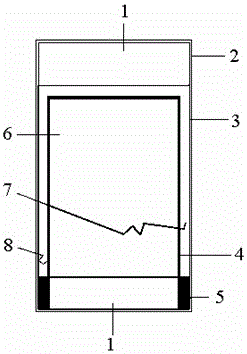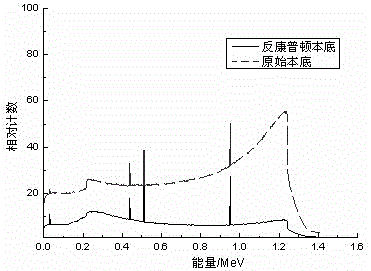Anti-Compton Scattering Detector
An anti-Compton and detector technology, applied in radiation measurement, X-ray energy spectrum distribution measurement, X/γ/cosmic radiation measurement, etc., can solve the problems of harsh working temperature and non-portability of the main detector , to achieve the effects of reducing detectable activity, saving practical costs, and realizing miniaturization
- Summary
- Abstract
- Description
- Claims
- Application Information
AI Technical Summary
Problems solved by technology
Method used
Image
Examples
Embodiment Construction
[0019] The structure of the anti-Compton scattering detector is as follows figure 1 As shown, it includes a main detector 6 made of sodium iodide material, the lower end of the main detector 6 is connected to a photomultiplier tube 1, and the main detector 6 is nested into a plastic scintillator to make a synthetic "well" type auxiliary detector 3, figure 1 It is a cross-sectional view of the detector. The main detector 6 is cylindrical and embedded in the auxiliary detector 3, so the auxiliary detector is a well type. There is a photoconductive material 4 between the main detector 6 and the auxiliary detector 3, and the upper end of the auxiliary detector 3 Connect the photomultiplier tube 1, the lower end of the auxiliary detector 3 is a lead shielding ring 5, the outer layer of the main detector 6 and the auxiliary detector 3 is packaged with a metal shell 2 coated with a magnesium oxide reflective layer.
[0020] In order to extract the γ-rays produced by the low-count tar...
PUM
 Login to View More
Login to View More Abstract
Description
Claims
Application Information
 Login to View More
Login to View More - R&D
- Intellectual Property
- Life Sciences
- Materials
- Tech Scout
- Unparalleled Data Quality
- Higher Quality Content
- 60% Fewer Hallucinations
Browse by: Latest US Patents, China's latest patents, Technical Efficacy Thesaurus, Application Domain, Technology Topic, Popular Technical Reports.
© 2025 PatSnap. All rights reserved.Legal|Privacy policy|Modern Slavery Act Transparency Statement|Sitemap|About US| Contact US: help@patsnap.com


